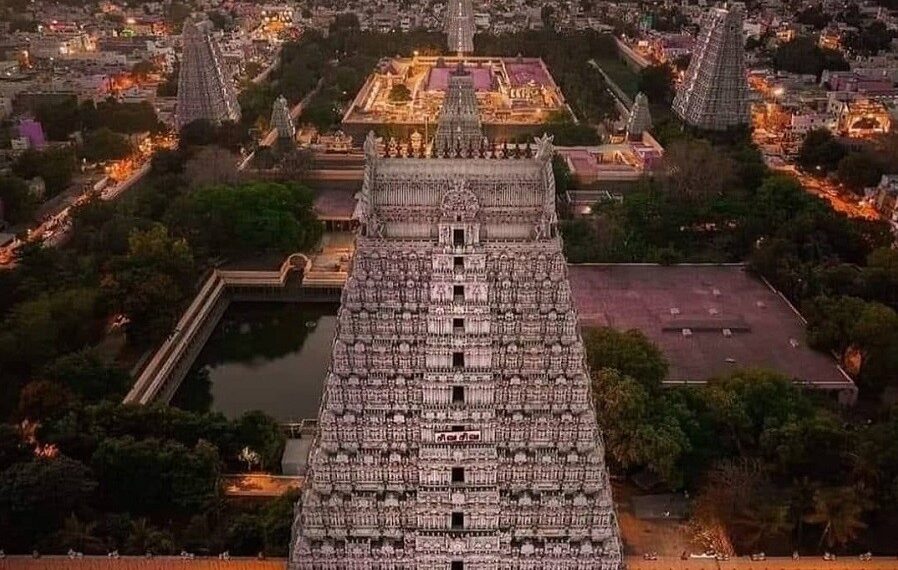The Annamalaiyar Temple, also called Arunachaleswarar Temple, is one of the famous temple site in Tiruvannamalai, Tamil Nadu, India. Located at the foot of the sacred Arunachala Hill, this temple is dedicated to Lord Shiva and is represented as the fire element in the Pancha Bhoota Sthalams, five Shiva temples tied to natural elements. Covering an area of 25 acres, it is one of largest temple complex in India, and naturally attracts millions of ardent devotees and visitors every year for its spiritual and religious importance, beautiful architecture, and captivating festivals.
History of Annamalaiyar Temple
The Annamalaiyar Temple has quite a long and rich history spanning centuries, shaped by kings, saints, and devotees. References to the temple and the sacred Arunachala Hill appear in Tamil literature from around the 1st century BCE itself and even before. In fact, ancient Tamil poets like Nakkirar also mentioned this sacred place in their works. However, the temple as we know it began to take shape under the Pallava dynasty before the 9th century CE, as shown by early inscriptions found in the temple.
The Chola dynasty, that ruled from 850 to 1280 CE, greatly expanded the temple. Various stone inscriptions from this time describe donation of land, cattle, and oil for lamps from affluent families and royals, showing the temple’s significance. The Cholas laid the foundation for its growth by building the main structure of the temple. An inscription confirms that the temple’s core was built around the 9th century CE, making it a key center for Tamil Saivism, a branch of Hinduism devoted to Lord Shiva.
After the Cholas, the Vijayanagara Empire (1336–1570 CE) added to the temple’s glory. Towering 217 feet into the sky with its 11 elaborately sculpted tiers, the majestic eastern gateway—known as the Rajagopuram—was begun during the reign of Emperor Krishnadeva Raya (1509–1529 CE) and later completed by Sevappa Nayaka in 1572 CE. It remains one of the tallest temple towers in all of India. The temple’s eastern tower rises high, covered in fine stonework that portrays gods, spiritual beings, and scenes passed down through myth. Its scale and detail speak not only of devotion but of the artistry of the era. During the reign of the Vijayanagara kings, another significant addition was made—a spacious hall supported by a thousand pillars which it brought people together for rituals and important gatherings.
Over time, the Annamalaiyar Temple and Tiruvannamalai region experienced many changes in rulership. By the 1600s, the Nawab of the Carnatic held sway, a sign of wider transformations in the area. In the following years, power shifted among different leaders—some Hindu, others Muslim—each influencing the temple and town in their own way. Tiruvannamalai was also taken over by the French in 1757, however their reign was brief. Then, in 1760, the British seized power, continuing the external governance pattern. By 1790, the town had been taken by Tippu Sultan, who included it in his growing empire.This period, like many others in South India, was characterized by frequent shifts in the balance of power. In 1951, the Tamil Nadu government’s Hindu Religious and Charitable Endowments Board, or HR&CE, began overseeing the temple, a role it still holds today. In 2002, the Archaeological Survey of India named the temple a national heritage site for a short period, but after local people raised concerns, the HR&CE took back control.
The temple’s spiritual story is just as meaningful. Back in the 7th century, Nayanar saints Appar and Sambandar wrote beautiful hymns about the temple in their collection called Tevaram. These songs made it a Paadal Petra Sthalam, a special Shiva temple loved by many. Another saint, Sekkizhar, shared stories of these saints in his book, Periyapuranam. Much later, holy figures like Ramana Maharshi and Seshadri Swamigal brought people from all over the world to Tiruvannamalai, drawn to the temple’s peace and the sacred Arunachala Hill.
Architecture of the Temple
The Annamalaiyar Temple is a stunning illustration of Dravidian architecture, with its towering towers and finely carved stones. The temple complex covers 25 acres and is surrounded by high walls with four gopurams, or entrances, facing east, west, south, and north. Adorned with elaborate images and sculptures of divine dancers, deities, and scenes from mythology, the eastern Rajagopuram is the tallest of all. Each of the other three gopurams—Tirumanjana, Pey, and Ammani Ammal—contributes a unique element to the temple’s appearance.
The temple’s interior is divided with seven prakaras, or enclosed spaces. The innermost one is home to the Agni Lingam, where people pray to Lord Shiva as Annamalaiyar. Not far off is the shrine for Goddess Parvati, honored as Unnamulai Amman. The thousand-pillared hall, built long ago by the Vijayanagara rulers, has pillars covered in images of deities and tales from ancient epics. There’s also the Shivaganga tank, a sacred water body, and smaller shrines for Ganesha, Murugan, and Vishnu, making the whole place feel even holier. The sanctum uses a unique gold-based material called Swarnabandana, different from the usual Ashtabandana used in other temples.
Religious Importance
The Annamalaiyar Temple is deeply sacred as one of the Pancha Bhoota Sthalams, standing for the element of fire. Old Hindu stories say Lord Shiva appeared as a huge column of fire on Arunachala Hill to show he was greater than Brahma and Vishnu, who couldn’t find its top or bottom. In another legend, Goddess Parvati covers Shiva’s eyes in mischief, causing the world to go dark. Only after praying on Arunachala Hill, Shiva appeared as the Agni Lingam, bringing back light. These stories tie the temple to ideas of cleansing the soul and growing spiritually.
The temple is also a Manipooraga Sthalam, connected to the chakra of freedom, and an Athara Sthalam, where heavenly beings are said to pray. Arunachala Hill itself is seen as a lingam, a form of Shiva’s presence. Walking around the hill, a 14-km ritual called Girivalam, is a holy act that many believe washes away sins and leads to moksha, or freedom from the cycle of life and death. People gather in great number to do this during full moons and big festivals.
Festivals and Rituals
Karthigai Deepam, taking place in November or December, is the largest festival among the temple’s many festivities. After 17 days, a massive lamp that can be seen from a great distance is lit atop Arunachala Hill. During this period, millions of people travel the Girivalam road and participate in processions. Maha Shivaratri, Navaratri, and Chithirai Vasantha Urchavam are some other festivals. Priests maintain the temple’s sacred essence by performing six rituals daily, such as Usha Kala Pooja at 5:30 AM, Kalasanthi at 8:00 AM, and Arthajama at 9:00 PM.
Conclusion
The Annamalaiyar Temple is a deeply spiritual and historic site in Tamil Nadu. Its growth from a small shrine to a grand complex shows the devotion and effort of kings, saints, and the general people over millenniums. With its beautiful design, deep spiritual roots, along with lively festivals, the temple continues to shine as a symbol of faith for Hindus and their rich culture.











